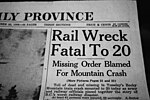The Canoe River train crash occurred on November 21, 1950, near Valemount in eastern British Columbia, Canada, when a westbound troop train and the eastbound Canadian National Railway (CNR) Continental Limited collided head-on. Twenty-one people were killed: 17 Canadian soldiers being deployed in the Korean War and the two-man locomotive crews of both trains. The post-crash investigation found that the order given to the troop train differed from the intended message. Crucial words were missing, causing the troop train to proceed on its way rather than halt on a siding, causing the collision. A telegraph operator, Alfred John "Jack" Atherton, was charged with manslaughter; the prosecution alleged he was negligent by passing an incomplete message. His family hired his Member of Parliament, John Diefenbaker, as defence counsel. Diefenbaker joined the Law Society of British Columbia in order to take the case, and obtained Atherton's acquittal. After the accident, the CNR installed block signals on the stretch of track on which the crash occurred. The railway later rerouted the main line in that area, eliminating a sharp curve which prevented crews from seeing approaching trains. Diefenbaker's successful defence of Atherton became an asset in his political rise. Two monuments, one near the crash site and the other in Manitoba, honour the soldiers who died in the crash.
Recently selected: Johnstown Inclined Plane - NSB El 18 - Infrastructure of the Brill Tramway
